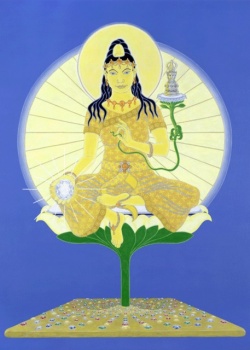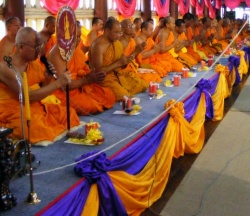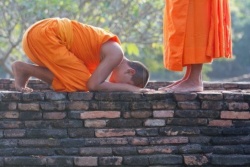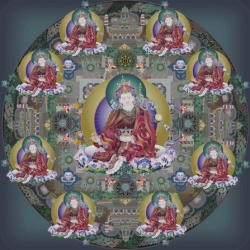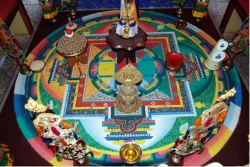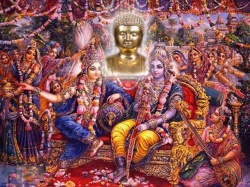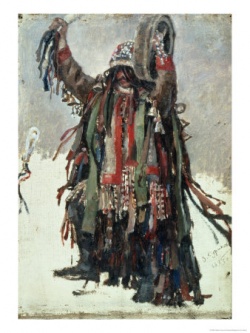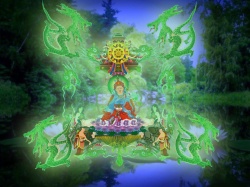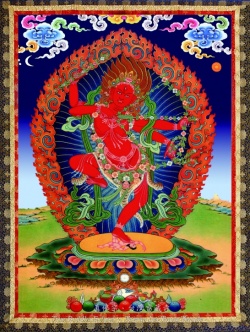Mamaki
Mamaki (Skt. Mamakī; Tib. མ་མ་ཀི་, Mamaki; Wyl. ma ma ki) — one of the five female buddhas and the consort of Ratnasambhava.
Mamaki (Skt. Mamaki; Tib. ???????, Mamaki; Wyl. ma ma ki) — one of the five female buddhas and the consort of Ratnasambhava.
Mamaki is another important deity who is said to be originated from seed syllable, Mam. Mamaki is blue in colour. Mamaki is the embodiment of the water element. Mamaki belongs to vajra family and is the nature of hatred. Her recognition symbol is Vajra. Mamaki is the consort or Prajna of Buddha Akshobhya. Her another name is Dvesarati.
Mamaki resides in the south west corner. Mamaki too has many forms. She can be found in two armed, six armed, eight armed and twelve armed forms. In two armed form she is depicted holding a vajra with her right and her left hand resting on her thigh. In another case she is seen displaying varada mudra with her right hand and the stalk of an utpala with her left.
According to Tantric Buddhist symbolism of Newar Buddhist tradition there is a special ritual worship of Mamaki in the form of triad ritual objects (Newari: Anti, Khayakori and Thapin). The Newari word Anti is a special jar used for keeping fermented wine, Khayakori for Yoghurt and Thapin for keeping fermented beer.
Mamaki is the golden yellow female Buddha of the South, the consort of Ratnasambhava. In one recent painting of Mamaki, she sits in a jewelled background (she belongs to the Ratna or jewel family). The jewels prompt reflections on the multi-facetted associations of precious gems.
Mamaki, greedy, Buddhist goddess, is the Shakti of Ratnasambhava or Aksobhya, also a bodhisattva or future buddha. She originated from the blue mantra MAM. Her color is yellow or blue, and attributes are cup, flowers, jewel, knife, and staff. A.G.H.
Mamaki, who is Ratnasambhava’s consort. Her name means “she who makes everything her own.” Mamaki looks on all things as identical with herself, because she knows the inner unity of Shunyata or emptiness which lies at the heart of all beings.
She delights in and appreciates everyone and everything. Mamaki A goddess. A shakti of Akshobhya or of Ratnasambhava. Mother of Vajrapani.
Mamaki. One interpretation of her name is “the mine maker” (Identifying with everyone). Equality & Abundance. The element of water, which exists within us as a certain energy, is transformed or ripened to become Mamaki
The image has been drawn out of and based on the book written by Vessantara, ‘The Five Female Buddhas’ 2004.
Time of day: noon
Emblem: jewel
Seed-syllable: MAM
Magical function: increasing
The Pure Land of Ratnasambhava is in the south, called Shrimat.
In Bardo Thodol, Tibetan Book of the Dead, he is depicted in union with his female consort Mamaki and attended by the male bodhisattvas Akashagarbha and Samantabhadra and the female bodisattvas Mala and Dhupa.
Together with his consort Mamaki he sits on the throne supported by horses.
He is accompanied by two bodhisattvas Akashagarbha and Samantabhadra, and two bodhisattvas, Mala and Dupa. Altogether in the space of rainbow light six images of Buddhas are shining. The yellow light of aggregate of senses (vedana-skandha) in its pure dimension is a Wisdom of Equality - radiant, decorated with disks of rainbow light, bright and sparkling, unbearably bright to the eye, will radiate from the heart of Ratnasambhava and his consort into your heart ...”
The female Buddhas are Locana, consort of Akshobya, Mamaki, consort of Ratnasambhava, Pandaravasini, consort of Amitabha, Tara, consort of Amoghasiddhi, and Akashadhateshvari, consort of Vairocana. These male and female figures are depicted in sexual union.
Strangely for us perhaps this has nothing to do with sex, there is no erotic content to these images. This is sexual symbolism.
In the Tantra this is profound and sacred symbolism, expressing the highest Truth. These images, known as Yab-Yum, are symbolic of the unity or oneness of Wisdom and Compassion.
The female Buddha represents the Wisdom aspect and the male Buddha represents the Compassion aspect, which is the active aspect of Enlightenment. The sexual embrace symbolizes the fact that there is no distinction between Wisdom and Compassion, they are just two ways of speaking about, or two ways of seeing, what is in fact a total experience. So, the final message of the five Wisdoms is that Wisdom is Compassion.
Elements of the Visualization The Earth Mandala If you are performing the full sadhana (whether in-front or generating y ourself as Mamaki), you begin by seeing an earth mandala emerge from the blue sky of emptiness. This earth mandala is the essence of the qualities of the earth element. It is visualized as square in shape and completely flat. It shines brilliantly against the blue sky because it is made of yellow jewels. If you are performing the visualization and you find it difficult to feel the solid, rooted earth element qualities in something that is made of light, then you could try imagining rocks and mountains, great trees and earthy fields all dissolving int o the earth mandala. (You can do something equivalent with all the element mandalas in these visualizations.)
The Golden Throne If you want to visualize in a slightly more extensive way you can include the thr one and animals at this point. Mamaki’s throne is made of gold, a kind of crystallization of the riches of her mind. Sangharakshita associates gold with the Second Precept, which concerns not stealing but giving generously. In working with this precept we aim to transform our state of mind from a poverty mentality to a wealth mentality. When you are in an impoverished state of mind it feels as if there is not enough of anything to go around. You have to fight to get your share, and if you succeed then you hold onto it because if you give any of it away the universe will not provide you with any more.
In a wealth mentality it feels as if there is plenty for everyone, you enjoy making others happy by giving and sharing, and you trust that under the law of karma your generosity will set up the conditions for you to have even more resources in future. I f, like Mamaki, you were seated on a great throne of solid gold then you could practise generosity unthinkingly, to your heart’s content.
The Camels The golden throne is supported by camels. These animals are associated with hot countries, and the ability to survive in places where the Sun beats down relentlessly . As well as being associated with the desert heat, camels represent endur ance, the stamina and steadiness of the earth element.
A camel can travel up to 100 miles a day in temperatures over 40 degrees Celsius. Also they have associations with sand, which can be heaped up into all kinds of extraordinary shapes, and yet all these forms are made of small pieces of silica. This for me is a reminder of the wisdom of equality. These camels are one-humped Arabians, generally associated with hotter place s than the smaller Bactrian camels that have two humps. Whilst not amphibious, they are associated in many people’s minds with two elements, as they are wonderfully adapted to cope with lack of water.
They store it not in their humps but in pouches in their stomachs. To replenish its reserves a thirsty camel can drink as much as gallons (120 litres) of water. From the centre of the earth mandala grows a pale-yellow lotus flower, on which rests a moon mat. On the moon mat appears the female Buddha Mamaki. She is yellow in colour, seated in the posture of royal ease.
Some Bodhisattvas are represented almost lolling on the ground in what is described as royal ease with one hand behind them on the ground. Mamaki’s posture is like some forms of Padmasambhava, seated straight, but with the right foot down. The main point is that her posture should be upright but very relaxed. She is dressed in exquisite clothing, and is adorned with an amber necklace, as well as other ornaments made of gold and precious things. Amber is another of Sangharakshita’s Ten Pillars of Buddhism. He associates i t with the fifth of the Ten Precepts: avoiding harsh speech and practising kindly communication.
Amber comes in different shades, but some are honey-coloured and warm to the touch, a bit as if you were holding a small piece of crystallised sunl ight in your hands. Sangharakshita makes the point that amber can be rubbed to produce an electrical charge, so that it attracts things to it, just as friendly spee ch draws people to you. Her right hand is in the mudra of supreme giving, palm turned out by her right knee, and holds a wish-fulfilling gem. This mudra of generosity is known as the varada mudra in Sanskrit.
The gem that Mamaki holds can be a single jewel or a triple-gem of golden-yellow, blue, and red, as you often see in Tibetan art. These three colours of course are associated w ith the Buddha, Dharma and Sangha respectively. You could even think that the upper part of the jewel reflects Mamaki's yellow radiance, the blue lower left part reflects that of Locana, who is on one side of her in the mandala, and the red lower right part reflects that of Pandaravasini, who is on the other side of her. However you see the jewel, the main thing to bear in mind is that it is no ordinary jewel but a jewel that fulfills all wishes (Skt: chintamani ).
This is what Mamaki is offering you with her open palm – the complete fulfillment of whatever you desire. We know from many folk tales that it is easy to squander your chance when a magical being turns up and offers you three wishes.
So it is worth being careful about what you wish for.
The wish-fulfilling jewel is a symbol for the Bodhicitta, that spiritual forc e that enables the Bodhisattva to vow to rescue all beings from suffering. It is this t hat is the true fulfillment of everything that you wish for. Only if we understand the nature of the ‘me’ that is wishing for happiness, and open our heart to the wider world will the happiness that we long for come about. Her left hand is in front of her heart in the mudra of bestowing the protection of the Three Jewels In this gesture, the palm is turned outwards, with the thumb and ring finger touching (or in this case holding the lotus stem), whilst the other three fingers are all raised to symbolize the Three Jewels.
It is a gesture often made by forms of Tara, but he re it has crossed the mandala to associate itself with Mamaki. She is holding the stem of a pale-blue lotus flower that blossoms at her left shoulder. On it is a moon mat, upon which stands a vajra-bell. Like all the Prajñas, she has the vajra-bell of wisdom. In each case it is on the left side of the body, as in Buddhist Tantra the right side is associated with compassionate skilful means and the left with wisdom.
On her head is a five-jeweled crown. She has long black hair, some of which is bound in a topknot, the rest flowing over her shoulders. In front of her topknot sits the deep yellow Buddha Ratnasambhava. He is in the vajra posture, his right hand in the mudra of supreme giving, and his left resting in his lap supporting a treasure vase. In early versions of the Mamaki sadhana,
I described Ratnasambhava as having a wish-fulfilling jewel in his left hand, and gave the treasure vase as an alt ernative. He is traditionally represented with the jewel. However, as time went on, the Ji nas’ attributes started to change in their new context within the visualizations of the Prajñas, and I reversed things so that Ratnasambhava held the treasure vase, givin the jewel as an alternative.
The treasure vase (Skt: kalasha) is a fat-bellied vessel with a short, slim neck. Its opening is crowned by a jewel. In Buddhist legend it is an inexhaustible source of riches. Vases of this shape are used in some Tibetan rituals. For example, they a re sometimes filled with jewellery and other valuables and buried on the site where temple is to be built, or under a house whose occupants wish to attract good fortune. The vase’s link with the earth in this way makes it particularly appropriate to M amaki and Ratnasambhava. Mamaki's head and body are surrounded by auras of light.
She is very beautiful, serene and relaxed. Mamaki is serene and relaxed because her wisdom of equality gives her compl ete equanimity. She lives in a mental spaciousness that is far removed from the tensions of the Eight Worldly Winds:
The Seed-Syllable and Mantra Mamaki’s seed-syllable is MAM. The MAM has a long 'A' - so that it is pronounced like the 'a' in 'father'. Her mantra in this form of practice is OM RATNE SURAT NE MAM SVAHA. ‘Ratna’ means ‘jewel’, and like Locana’s mantra it is in the vocative form. ‘Su’ means ‘beautiful’ or ‘happy’. So in the mantra we are invoking Mamaki a s a jewel, a happy and beautiful gem.
The Mamaki Puja
Borrowing a phrase from the sixth section, I called the puja to Mamaki The Heart’s True Wealth. Its verses have a strong emphasis on spiritual riches. To perform the puja you should first call to mind Mamaki, and allow her yellow light and her abundance of good qualities to warm and enrich your mental state. Worship Buddha of beauty,/ Possessor of all riches,/ I, who own nothing at all,/ Must borrow from your infinite wealth/ To pay you homage./ From your treasury of good qualities/ I borrow the clear waters of purity,/ The delightful food and drink of Dharma teachings,/
The sweet perfumes of loving mental states,/ To pay you homage./ 34 From your treasury of good qualities/ I borrow yellow lotuses/ Of pure renunciation, Incense made of divine meditation,/ Butter lamps fashioned from wisdom’s gold,/
To pay you homage./ From your compassionate heart/ I borrow this precious human form,/ This devoted voice,/ These loving words,/ To pay you homage./ Buddha of beauty, - Beauty is not a quality particularly associated with the South in the Tibetan Buddhist tradition.
But Sangharakshita in his Tantric series of lectures characterizes Ratnasambhava as the Buddha of Beauty, though without giving any explanation. Gems are brilliant, alluring objects, so as the heads of the Jewel Family Mamaki and Ratnasambhava are strongly linked with the beautiful.
As with Locana, during the course of this verse we make the seven offerings to t he honored guest. Here there is no music – unless you want to sing the verses with the ‘devoted voice’ mentioned in the last verse! Possessor of all riches,/ I, who own nothing at all,/ Must borrow from your infinite wealth/To pay you homage. - These lines are not about self-effacing humility, or flattery. The fact is that ‘I’ as ego cannot truly possess anything. In the short term we can buy a car or a house, but we only enjoy them for a limited time, at the most for our lifespan before they pass out of our possession.
The ego is unstable, ‘like a bubble or a mirage’ as the Perfection of Wisdom texts say, so its ownership is also temporary and uncertain. From that perspective, everything that we have, even our physical body, is only borrowed from the universe, and one day will be returned. Contrast this with the Enlightened person who has found a state that is deathless, permanently fulfilling, and endlessly creative.
So in expressing devotion to a Buddha we have one of those ‘what do you give to the person who has everything?’ questions. Yet, to use another cliché, ‘it’s the thought that counts’. Even though Mamaki does not lack for anything, if we feel devotion for her and her qualities then that needs expression. I f the only worthy offerings that we can find have to be borrowed from her then it is st ill worth doing. From your compassionate heart/ I borrow this precious human form,/ This devoted voice,/
These loving words,/ To pay you homage. - You can take this verse as just a poetic image. But you can also see that Mamaki represents the true nature of our mind. This true nature is the union of the wisdom that perceives emptiness and of great compassion.
As all forms are emptiness, everything that we think of as ‘m e’ is just an appearance arising from that true nature of the mind. Our lives start to become rich and meaningful when, although still feeling ourselves to be isolated separate selves, we turn in the direction of that true nature of the mind again.
One way to do this is by personifying that true nature and expressing love and devotion for it. Salutation You have mined the jewels of wisdom/ In the depths of the heart,/ Now your form shines brilliant with their splendour./ Bathed in your wisdom light,/ On this jewel ground/ To you I prostrate./ You are the source of all giving,/ Open-hearted, open-handed./
You give without any sense/ Of a donor, recipient, or gift./ Offering myself to you completely,/ On this jewe l ground/ To you I prostrate./ You are higher than pride,/ Lower than humility,/ Equal to the unequaled./ With no thought of comparison/ On this jewel ground/ To you I prostrate./ Through emptying your mind/ Of any thought of ownership,/ You possess the entire world./ Giving up attachment/ To ‘my body’/ And ‘my mind’,/ On this jewel ground/
To you I prostrate./ You give without any sense/ Of a donor, recipient, or gift. - This form of giving is described as the perfection of giving (Skt: dana paramita ) in the Mahayana texts. The whole thought-structure of ‘I give this to you’ falls away in advanced practice.
What is left is a spontaneous, open-hearted generosity that does not keep score of who gave how much to whom. You are higher than pride,/ Lower than humility,/ Equal to the unequaled. /With no thought of comparison,... - There are a number of passages in the Pali Canon, for instance in the Sutta Nipata , in which the Buddha warns against comparing yourself with others. This isn’t just looking down on them, he also specifically cites thinking that you are inferior or equal as causes of suffering.
A certain degree of comparison is inevitable if you are to learn from life, but building that up into a view simply strengthens your sense of isolation. Through emptying your mind/ Of any thought of ownership,/ You possess the entire world. - You ‘possess’ the entire world by not narrowing down your identification to one place or one set of objects. As soon as you limit yourself in this way then everything else becomes ‘other’, ‘not yours’. Of course, when you give up this narrow thinking you don’t literally become the owner of the planet. It is more that you ar e free to enjoy everything.
It is like looking out at some countryside from a hillt op. If you don’t start thinking about ownership then you are able to enjoy the view on its own terms. Giving up attachment/ To ‘my body’/ And ‘my mind’,... -
When we think in terms of something being ‘mine’ we also subtly strengthen a sense that we control it in some way. (If you can’t control it, in what sense is it ‘yours’?) But both mind and body are only under our control to a limited extent. When we forget this fact we store up suffering for ourselves. Going For Refuge Queen of the zenith sun,/ Long have I wandered/ In the desert of samsara,/ Walking in circles of self-concern,/ Becoming mired in the quicksands of comparison,/ Thirsting for true satisfaction./ Now, at last,/ I turn to you for refuge./ Queen of golden light,/ I go for refuge to your wish-fulfilling jewel,/ An abundant treasury of compassion,/ Turning to dust the need for outward riches./
Queen of the earth element,/ I go for refuge to your generous heart,/ That offers this jewel of jewels/ To every living being./ Queen of the southern Pure Land,/ I go for refuge to your golden retinue:/ All those for whom there is no ‘yours’ or ‘mine’,/ And who live in perpetual contentment./ Queen of the vajra bell/ I go for refuge to your limitless mind,/ In which all phenomena are equal,/
So that nothing compares to you./ Queen of the southern Pure Land - There is no mention that I know of in the Buddhist texts of Mamaki having a Pure Land. Ratnasambhava’s Pure Land is known as Shrimat – the Glorious. Confession of Faults O you who grant all wishes,/ Please give me the courage/ To see myself as I am./ O you who grant all wishes,/ Please give me the kindness/ To acknowledge even the darkest/ Of my faults, failings, and unkindness./ O you who grant all wishes,/ Please give me the confidence/ To believe I can transform/ This rough carbon lump of a heart/ Into a wish-fulfilling gem./
O you who grant all wishes,/ Please purify me completely/ Of all narrow self- concern,/ Meanness and pettiness./ O you who grant all wishes,/ Please pour your golden-yellow light/ Into every dark corner of my being,/ Please turn the stony ground of my mind/
Into rich and fertile soil/ In which to sow the seeds/ Of perfection. To believe I can transform/ This rough carbon lump of a heart/ Into a wish-fulfilling gem. - Diamonds are formed from carbon that has been crystallized under tremendous heat and pressure deep down (often 120 miles) in the Earth’s crust. In the same way through the intensity of spiritual practice we can transform ourselves into a Bodhisattva. Rejoicing in Merits Appreciation is a wish-fulfilling gem/
That causes all beings to grow and prosper./ It is the antidote to lonely pride and separateness./ So I shall value the good in all that lives./ I shall sing the praises/ Of those whose merits are great or small./ I rejoice in those who have heaped up/ Jewel mountains of good deeds,/ And in those who,/ In the darkness of unawareness,/ Have found even one tiny gem./ I rejoice in all those/ Who create mundane beauty:/
The artists, poets, and composers,/ And all the bringers of learning and culture./ I rejoice in all those/ Who by their skilful actions/ Collect diamonds, gold and crystal;/ Who with their beautiful speech/ Heap up pearls and amber,/ Silver and opal;/ And those whose minds are ablaze/ With the light of emeralds, rubies and sapphires.
Above all I rejoice in your beauty,/ Your serene form,/ Regal yet relaxed,/ Your speech like liquid amber,/ Your mind of light,/ That experiences all phenomena/ As adornments/ Fashioned from the gold/ Of emptiness./ Fourth verse - This verse uses all of Sangharakshita’s ‘ten pillars’ to rejoice in people who practise the Ten Precepts. This doesn’t simply mean people who have consciously taken these precepts on.
These ten embody every positive action of body, speech and mind. Thus they are known as the 10 Skilful Actions (Pali: kusala dhamma ). Your mind of light,/ That experiences all phenomena/ As adornments/ Fashioned from the gold/ Of emptiness. For those familiar with Chinese Buddhist thought this will call to mind the Hua Yen teacher Fa Tsang’s Treatise on the Golden Lion.
In this brief text he explains the nature of reality to the Empress Wu, by taking the example of a lion made of gold that guards her palace hall. The teaching is very deep, and there ar e different interpretations of it. According to one view, he describes the interplay of dependent arising and emptiness as being like the relation between the form of the lion and the gold of which it is made up. Fa Tsang starts by saying that it is because gold is shunya – lacking any inherent existence – that it can be fashioned into endless forms, such as the Empress’s lion.
This emptiness of inherent existence is not something that stands behind phenomena and gives birth to them. Rather phenomena are emptiness. The lion has not appeared out of gold; it is itself gold. Just as you always experience gold in a particul ar form: a gold bar, a necklace, a lion statue, so you never experience emptiness separate from dependently-arising phenomena.
More than this, although the gold appears in the shape of a lion, there is no real lion there, there is just gold. From the viewpoint of gold, as it were, nothing has changed, whether it is formed into a bracelet or a coin. Thus from an absolute point of view there is only emptiness. Fa Tsang takes his arguments much further than this, into some very philosophically demanding territory. But hopefully this is enough to gain a sense of how the analogy between gold and emptiness can work.
Entreaty and Supplication O Jewel Queen,/ You who hold the gem/ That grants all desires,/ May these wishes/ All come true:/ In this very life,/ Through sincere striving on your path of light,/ May I discover the One Jewel:/ The Bodhicitta, the heart’s true wealth,/ Of which all mundane gems/ Are worthless imitations./ May your golden radiance/ Always illuminate the world./ May you pour the Dharma/ Like liquid sunshine/ Upon all living beings,/ For as long as time exists./
See Paul Williams’ Mahayana Buddhism (Routledge, London, 1989), pp 130-4.
May all beings, your children,/ Turn like sunflowers toward you,/ May they experience your wisdom-mind./ May they all become equal to you/ In Enlightenment./ Transference of Merits May the merits of this worship/ Never be lost,/ Or stolen by the thieves/ Of anger, regret, or false views./ To keep them safe forever,/ I offer them to you, O Jewel Queen./
Please store them in your heart/ Like buried treasure,/ And there, by your rite of increase,/ May they be multiplied and transformed./ May they turn into radiant goddesses/
Making you sublime offerings./ May they become a rain of flowers/ Falling at the golden feet/ Of the noble Ratnasambhava./ May they transform into Bodhisattvas/ Rescuing beings in the ten directions./ May they transmute into an abundance of Dharma,/
A harvest of happiness,/ For every living being./ Or stolen by the thieves/ Of anger, regret, or false views. – In Buddhist tradition there is the idea that through skilful action you gain merit, which in time results in happiness for you. However, it is also said that the effects of these meritorious dee ds can be cancelled out. For example, if you act generously but later regret i t and wish that you had not given, this will undermine the positive effects of your generosity
Similarly the Bodhisattva builds up a tremendous stock of merits through practising the Perfections, but it is said that this can be destroyed if he or she then generat es states of anger towards the beings that they have pledged to help. In traditional Buddhist countries all this is often taken very literally, with merit becoming a commodity, like some sort of spiritual equivalent of the Euro. But the basic principle - that the effects of positive actions can be mitigated by subsequent unhelpful mental states, and vice versa - is just basic Buddhism.
And there, by your rite of increase, / May they be multiplied and transformed . - Tantric Buddhism made use of various magical rituals common in India, but changed their purpose. So it took magical rites designed to ensure good harvests and transformed it into a rite for the purpose of increasing wisdom and compassion. Rescuing beings in the ten directions. – The ten directions are the cardinal and intermediate points of the compass, the zenith and the nadir, i.e. everywhere!
